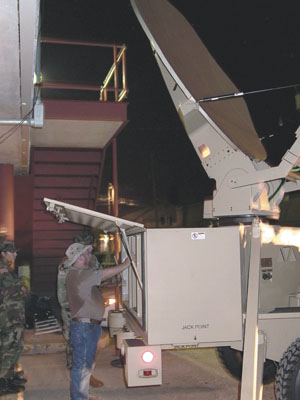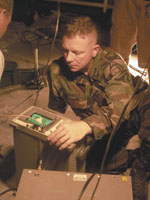Military Systems Restore Communications To Devastated Region
 |
| The team sent by the U.S. Army’s Communications-Electronics Life Cycle Management Command (C-E LCMC), Fort Monmouth, New Jersey, to support disaster relief efforts following Hurricane Katrina came equipped with several satellite communications transportable terminals (STTs). Highly automated, STTs can acquire a communications satellite automatically and can support a variety of wireless telephones and laptop computers. |
After the winds of Hurricane Katrina subsided, the
Because the storm had devastated the local infrastructure completely in the hardest hit regions, the military shipped mobile satellite communications terminals to the
The team arrived at the
Equipped with five satellite communications transportable terminals (STTs), the C-E LCMC team enabled soldiers from the 82nd Airborne Division, the Federal Emergency Management Agency (FEMA), and
The STT equipment that supported the hurricane relief efforts is a new version that has not yet been issued to the military. Housed in a single trailer, it can accept connections directly from laptops and telephones. Highly automated, the STT’s dish antenna acquires a satellite immediately when the antenna is raised.
Chief Warrant Officer Kobsar praises the performance of the STTs in the field. The only difficulty encountered was rain fade during the hurricane, which was not the fault of the equipment but was due to the Ku band’s wavelength, he explains.
The C-E LCMC equipment served as a backup for the damaged infrastructure by “injecting” a satellite-based communications link from a cellular base tower into a public telephone network via a communications hub in
The mission then shifted to provide six
From its initial base in
Although Hurricane Rita disrupted operations, it also was the busiest time for the group. While the new storm delayed operations briefly, it did not damage any of the communications systems already put in place. The team pulled out of
The weekend immediately following the second storm, five terminals were set up: two in
 |
| Chief Warrant Officer Joseph Kobsar, USA, uses an oscilloscope to verify the exact setting of a satellite downlink on a rooftop at the Louis Armstrong New Orleans International Airport. Operating in devastated areas with little or no infrastructure, the C-E LCMC team relied on pre-staged equipment and its members’ experience supporting military deployments. |
For example, in the town of
In
Oakdale’s fire chief was provided with a communications network covering 20 miles, wireless laptops and 20 wireless base-band time division multiple access packages. The system allowed different types of first responder radios to form networks across parish lines. “So it was no longer just to the one parish; they were tied into the state emergency operations center. Now you had a linked system from first responders to the Defense Department, all the way up to the state emergency operations center. Everybody was on one plane as far as communications was concerned,” he relates.
The base-band packages, CDMA bent pipes and ACU-1000s installed by the team will remain in the region. There is also a contract to provide a commercial satellite backhaul capability for the area. Once the commercial systems arrive, the STTs will be replaced, he explains.
To operate in these devastated zones, the
The team improvised while operating on the
Another lesson learned from the experience was the importance of ensuring that the communications team transmissions site is jointly operated by the federal government, state government, National Guard and FEMA. “It needs to be a joint center where all three or four groups can come together without issues,” he says.
C-E LCMC personnel also discovered that Ku-band satellite communications are affected by rain fade. As Hurricane Rita approached, the team encountered considerable rain fade when it deployed its STT dishes. The interference occurred because the Ku band’s wavelength is sensitive to atmospheric effects such as rain. “A single drop can affect your signal,” the chief warrant officer maintains.
Based on this experience, Chief Warrant Officer Kobsar does not believe Ku-band systems are suitable for hurricane relief. “There needs to be many different bands because if it’s raining real hard, you’re not going to get communications through,” he observes.
The C-E LCMC team is writing a report to present to the chief information officer/G-6, the U.S. Northern Command and FEMA about its experiences in Hurricane Katrina relief support efforts. The goal is to help develop a solution that will meet the government’s needs in any future catastrophic event, the chief warrant officer says.
Web Resource




Comments